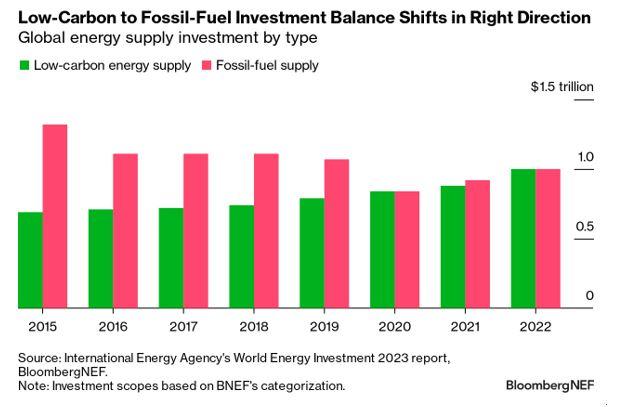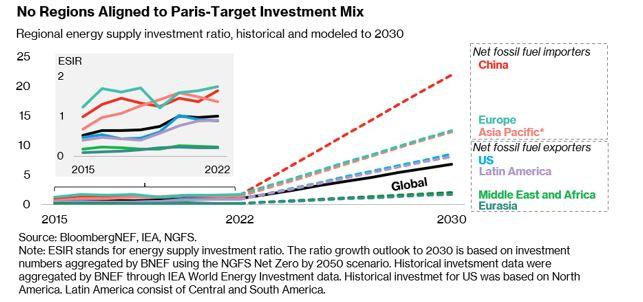Regional Investment in Low-Carbon Energy Is Short of Net-Zero Path
Originally published on bnef.com
Staying on track for net-zero emissions requires at least $4 dollars to be spent on low-carbon energy supply for every dollar that goes to fossil fuels throughout this decade. But this global picture, derived from BloombergNEF analysis of commonly referenced climate scenarios, masks the regional nuances in the capital expenditure needed to limit global warming to 1.5C.
New research from BNEF explores these variations, revealing that China, for example, must achieve a ratio of 10-to-1 by 2030, while for the Middle East it is just 1.1-to-1. No market’s investment mix is currently aligned to the pathways necessary to meet the goals of the Paris Agreement.
Parity achieved
Globally, the energy transition is moving in the right direction. Investment in low-carbon and fossil-fuel energy supply hit parity for the second time ever in 2022, based on BNEF’s aggregation of the International Energy Agency’s World Energy Investment data. That’s up from 0.5-to-1 in 2015, the year the Paris Agreement was signed.
China and Europe have led the investment shift, with their ratios reaching 1.6-to-1 and 1.7-to-1, respectively, last year. North America lagged at 0.9-to-1, mainly due to a strong oil and gas production footprint, while major fossil-fuel exporters like the Middle East and Eurasia saw spending on low-carbon energy amount to just a fraction of their oil and gas investment. These regional differences reflect the availability of energy supply resources and associated government policies.
Not on track for 1.5C
Much more must be done to scale up investment in low-carbon supply and enable a reduction in fossil-fuel spending this decade. A linear increase from 2022 signals the need for the ratio to rise by 0.74 each year to match the 4-to-1 balance required.
BNEF has reconciled historical energy investment data from the IEA with a forward-looking regional dataset from the Network for Greening the Financial system to explore the outlook by market.
Net fossil-fuel importers China and Europe have the highest implied average ratios across 2021 to 2030 at over 10-to-1 and 6.5-to-1. This illustrates the large opportunity they have to scale their low-carbon supply investment most rapidly. Conversely, the Middle East and Africa and Eurasia have the lowest implied decadal ratios at 0.9-to-1, reflecting the expectation that they will continue to produce and export fossil fuels.
The investment outlook differs across regions due to a multitude of underlying factors, such as economic development, population growth and varying energy mixes. No region is currently on track to meet these ratios.
Financial institutions active in different regions of the world may wish to consider this and Nationally Determined Contributions – countries’ plans to help meet the goals of the Paris Agreement – when formulating their investment and financing policies.
About BloombergNEF
BloombergNEF (BNEF) is a strategic research provider covering global commodity markets and the disruptive technologies driving the transition to a low-carbon economy. Our expert coverage assesses pathways for the power, transport, industry, buildings and agriculture sectors to adapt to the energy transition. We help commodity trading, corporate strategy, finance and policy professionals navigate change and generate opportunities.




